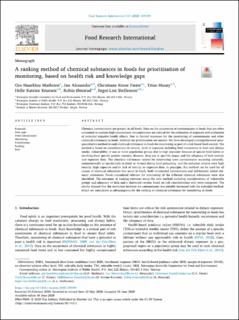| dc.description.abstract | Chemical contaminants are present in all foods. Data on the occurrence of contaminants in foods that are often consumed or contain high contaminant concentrations are critical for the estimation of exposure and evaluation of potential negative health effects. Due to limited resources for the monitoring of contaminants and other chemical substances in foods, methods for prioritisation are needed. We have developed a straightforward semi-quantitative method to rank chemical substances in foods for monitoring as part of a risk-based food control. The method is based on considerations of toxicity, level of exposure including both occurrence in food and dietary intake, vulnerability of one or more population groups due to high exposure because of special food habits or resulting from specific genetic variants, diseases, drug use or age/life stages, and the adequacy of both toxicity and exposure data. The chemical substances ranked for monitoring were contaminants occurring naturally, unintentionally or incidentally in foods or formed during food processing, and the inclusion criteria were high toxicity, high exposure and/or lack of toxicity or exposure data. In principle, this method can be used for all classes of chemical substances that occur in foods, both unintended contaminants and deliberately added chemical substances. Foods considered relevant for monitoring of the different chemical substances were also identified. The outcomes of ranking exercises using the new method including considerations of vulnerable groups and adequacy of data and a shortened version based on risk considerations only were compared. The results showed that the resolution between the contaminants was notably increased with the extended method, which we considered as advantageous for the ranking of chemical substances for monitoring in foods. | en_US |
